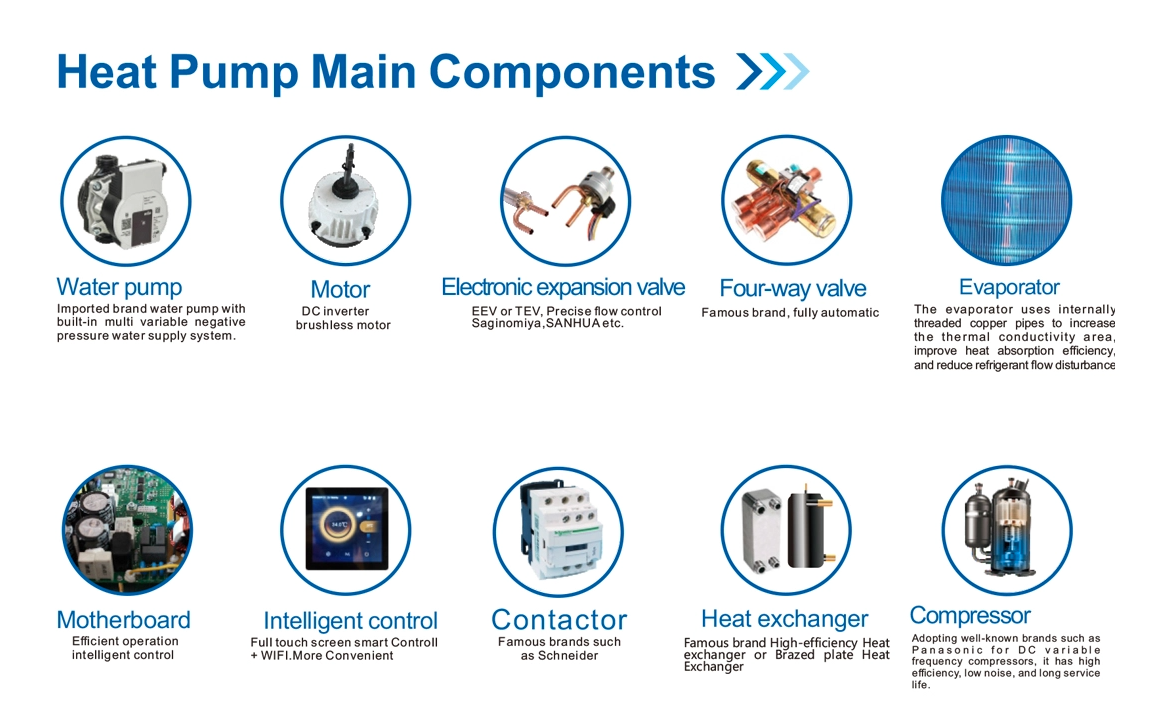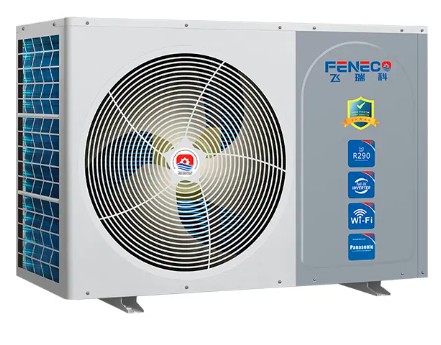Views: 0 Author: Site Editor Publish Time: 2025-09-12 Origin: Site








Looking for an energy-efficient way to heat and cool your home? Heat pumps are one of the most versatile and eco-friendly solutions available today. Unlike traditional furnaces that burn fuel to generate heat, a heat pump simply moves heat from one place to another, providing both heating and cooling in a single system. With their innovative design and high energy efficiency, heat pumps can significantly lower your utility bills while reducing your carbon footprint. Fineco New Energy Technology Co., Ltd. offers advanced heat pump solutions designed for modern homes, combining reliability, performance, and sustainability. In this guide, we’ll explore how heat pumps work, their key components, installation tips, and how to identify if your home already has one.
A heat pump is a clever device that looks like a big metal box sitting outside your house. It has a fan on top and lots of thin metal fins around the sides. Inside, a compressor works like a heart, pumping refrigerant to move heat around. This system can both heat and cool your home, making it super versatile. Unlike a furnace, which burns fuel to make heat, a heat pump just moves heat from one place to another. It’s like a magic trick, but with science! Heat pumps are known for their energy efficiency and can significantly reduce your utility bills.
The outdoor unit is the part you see outside. It’s a large metal box with a fan on top. Inside, there’s a compressor that pumps refrigerant and a condenser coil that releases heat. The fan helps to cool everything down. This unit looks a lot like an air conditioner, but it does more than just cool your home. It’s an essential part of your HVAC system, providing both heating and cooling functions.
The indoor unit, also called the air handler, is usually in your basement or attic. It looks like a big metal cabinet. Inside, there’s an evaporator coil that absorbs heat from the air and a blower that pushes the cool air through your ducts. There’s also a reversing valve that lets the system switch between heating and cooling. This part works with the outdoor unit to keep your home comfortable all year round. Proper installation and maintenance of the air handler are crucial for efficient heat pump performance.

Heat pumps are like heat-moving machines. In the summer, they take heat from inside your home and send it outside. In the winter, they do the opposite—they pull heat from the cold outside air and bring it inside. This might sound strange, but even cold air has some heat! The refrigerant in the system helps move the heat around. It changes from a liquid to a gas and back again, which helps it absorb and release heat. This process is what makes heat pumps so energy-efficient and environmentally friendly.
Air-source heat pumps and central air conditioners share a similar appearance, which can make it tricky to tell them apart at first glance. Both have an outdoor unit equipped with a fan and metal fins, but there are distinct features that set heat pumps apart.
Reversing Valve: This is a crucial component that allows the heat pump to switch between heating and cooling modes. It’s typically located near the compressor and looks like a horizontal brass pipe connected to several copper lines.
Labels and Markings: Heat pumps often come with labels that clearly state they are heat pumps. Additionally, the model number can provide clues. A quick online search of the model number can confirm if the unit is a heat pump.
Thermostat Settings: Modern heat pumps often have thermostats with settings for emergency heat or specific heat pump modes. These settings are unique to heat pumps and not found on traditional air conditioners.
Ground-source heat pumps, also known as geothermal heat pumps, have a less visible outdoor presence. Their heat exchange components are buried underground, making them harder to identify by appearance alone.
Underground Pipes: These systems connect to a series of underground pipes filled with refrigerant or water. The pipes are buried in loops or trenches, which means you won’t see much of the system above ground.
Indoor Connections: The indoor unit connects to these underground pipes and often looks similar to a traditional air handler. It contains the evaporator coil, blower, and reversing valve, just like an air-source heat pump.
Outdoor Unit: Check for the reversing valve and any labels indicating the unit is a heat pump.
Thermostat: Look for settings that suggest the system can provide both heating and cooling.
Ground Loops: If you suspect a ground-source heat pump, look for any signs of buried pipes or loops in your yard.
Identifying whether you have a heat pump or another type of HVAC system is essential for proper maintenance and understanding your home’s heating and cooling capabilities. Here’s a step-by-step guide to help you determine if you have a heat pump:
Outdoor Unit: Look for labels on the outdoor unit that indicate it’s a heat pump. The label might explicitly say “heat pump” or provide a model number you can search online.
Model Number: If the label doesn’t clearly state it’s a heat pump, note the model number. A quick search can reveal if the unit is designed for both heating and cooling.
Emergency Heat Setting: Modern heat pumps often have an emergency heat setting on the thermostat. This setting is unique to heat pumps and indicates the system can provide heating.
Dual-Function Modes: Look for modes or settings that suggest the system can switch between heating and cooling. This is a strong indicator that you have a heat pump.
Reversing Valve: Look for the reversing valve, which is a key component of heat pumps. It’s usually located near the compressor and looks like a brass pipe with copper lines attached.
Unit Operation: Turn on the heat and observe the outdoor unit. If the unit runs when the heat is on, it’s likely a heat pump. Traditional furnaces rely on indoor components for heating and don’t operate the outdoor unit in heating mode.
When installing a heat pump, you need to make sure there’s enough space around the outdoor unit. It needs at least 24 inches of clearance on all sides. This helps with airflow and makes it easier to maintain. The indoor unit should be in a central location, like a basement or utility closet, so it can distribute air evenly throughout your home. Proper spacing and placement are crucial for optimal heat pump performance.
For the outdoor unit, find a spot away from windows and living areas to keep noise down. The indoor unit should be in a well-ventilated area. This helps it work efficiently and keeps your home comfortable. Proper placement ensures that your heat pump can operate at its best, providing consistent heating and cooling.

Heat pumps move heat around using refrigerant. In summer, they take heat from inside and send it outside. In winter, they pull heat from the cold air outside and bring it inside. It’s like a heat-moving machine! This process is what makes heat pumps so efficient and versatile.
Place the outdoor unit away from windows and living areas to keep noise down. The indoor unit should be in a central location, like a basement or utility closet, so it can distribute air evenly. Proper placement ensures that your heat pump can operate efficiently, providing consistent heating and cooling.
A furnace burns fuel to make heat, while a heat pump moves heat from one place to another. Heat pumps are more energy-efficient and can also cool your home, making them more versatile. Unlike furnaces, heat pumps don’t rely on burning fuel, which makes them better for the environment.
In some cases, yes! Some heat pumps can work with existing furnaces. This is called a dual-fuel system. The heat pump handles most of the heating and cooling, and the furnace kicks in when it gets really cold. This setup can help you save energy and reduce your utility bills.
Ductless heat pumps are smaller and can be installed in specific rooms. They’re great for homes without ducts and can save energy by heating or cooling only the rooms you use. Ductless systems are also known for their flexibility and ease of installation, making them a popular choice for many homeowners.
Heat pumps are a smart investment for any homeowner seeking comfort, efficiency, and environmental responsibility. From air-source to ground-source systems, they provide year-round heating and cooling while saving energy and reducing costs. Whether you are considering a new installation or upgrading an existing system, proper placement, maintenance, and understanding your system’s components are key to maximizing performance. Fineco New Energy Technology Co., Ltd. is committed to delivering reliable and cutting-edge heat pump solutions that help you stay comfortable while lowering your energy footprint. Explore our products today and discover how a heat pump can transform your home into a more efficient and eco-friendly living space.
